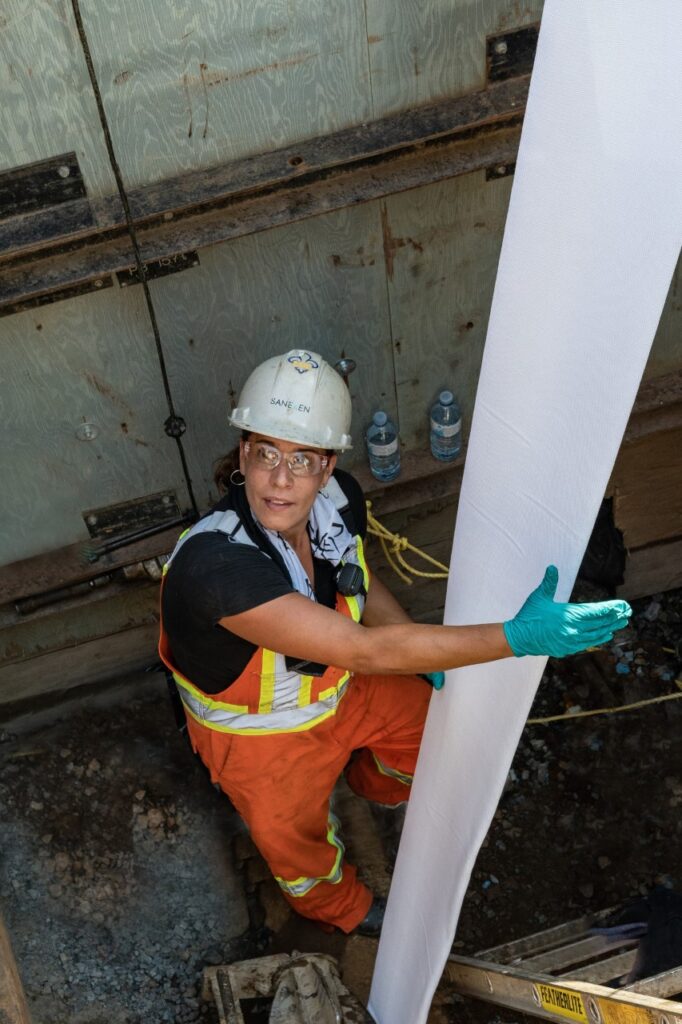ALTRA Proven Resilient Water Main Technology: SANEXEN

Projects Sponsor
Climate change is causing increasingly severe environmental conditions and events that threaten watermain infrastructure. Fortunately SANEXEN Environmental Services Inc., an environmental solutions provider, has developed ALTRA, a technology capable of renewing and protecting water lines. Determined to prove the resiliency of their innovation, the SANEXEN team subjected their innovative work to a series of testing at Cornell University. The results confirm that the technology maintains its integrity during an extreme full-scale soil disruption event and does not rupture, making it a potential game changer for cities around the world.
By Tabatha Southey (C) 2021
We’ve all seen at least images of watermains exploding after earthquakes, during floods, or in winter due to extreme cold. Some of us have even witnessed these disasters in real time, more of us likely will.
These incidents, after all, happen because we are, increasingly, at the mercy of the weather and also because many of the elements of our aging drinking water infrastructure are near or past their projected 50-year lifespan.
Indeed 50% of watermains in Canada and the USA are considered to be in poor condition or worse. In addition to the existing public infrastructure spending gap, the deteriorated conditions of watermains pose considerable un-addressed health risks as many mains contain lead and asbestos.
Traditionally, the answer to pipes deemed to be in poor condition has been to dig-and-replace as (urgent) needs be. This of course results in high labour and fuel costs as well as significant disruption to our communities over the course of many months, not to mention the associated negative environmental consequences.
If you’re thinking “There has to be a better way…” you’re not alone and you haven’t been for some time now: ALTRA, SANEXEN’s next generation water technology is the result of an ongoing research and development process that has been evolving for almost twenty years.
Between 1998 and 2000, SANEXEN undertook the development of its First Generation water technology for the rehabilitation subset of the watermain renewal market. Their technology uses a novel concept of double concentric sleeves of a circular plain weave fabric of textile yarns which allows for the on-site impregnation of a thermosetting resin. The impregnated sleeves are then pulled into the watermain to be renewed and cured in place, to be returned to service within 1-2 days.

After two years of testing, trials and design, Next Generation went commercial with its first installation in July 2000. They’ve now installed more than 2,100 km in over 350 North American cities.
Although superior to all other existing CIPP technologies, the product was not originally designed to exceed the structural standalone pipe capabilities of existing watermains. Over the years, the innovation team decided to leverage the structural properties they’d innovated to develop Next Generation.
With the development and implementation of this unique seamless structural water technology, intended to be a resilient product with much improved strength and stiffness and unique ability to adapt to host pipe, ALTRA aims to become the only viable trenchless alternative to conventional dig-and-replace methods for the entire potable watermains renewal market.
Their trenchless approach for renewing, rather than replacing, pipes saves considerable fieldwork time saved (typically six weeks vs. sixteen) and reduces costs (by up to approximately twenty to thirty percent of the cost of conventional dig-and-replace methods). As well renewal offers significant environmental benefits and greater watermain resilience benefits in the event of major soil disruptions.

Although confident in the data that SANEXEN’s engineering team had gathered over the years, all of which indicated that the resiliency of the product was unmatched, independent testing was arranged. In December 2019, seeking to put stakeholder’s minds to rest, a rigorous testing program was undertaken at Cornell’s Geotechnical Lifelines Large-Scale Testing Facility in Ithaca, NY.
This real time testing, performed with sponsors present, climaxed with the successful Large Fault Rupture Test. Test scenarios included among other factors, axial force (tension and compression), four-point bending and large-scale fault rupture. These are all forces that are present during seismic events and other events causing large ground deformations.
The tests confirmed conclusively that the pipe lined with ALTRA, SANEXEN’s Next Generation water technology, is able to withstand large degrees of ground deformation and abrupt ground rupture. Indeed, the testing showed the pipe would have kept its integrity through the most severe levels of liquefaction-induced ground deformation that occurred during the 1906 San Francisco earthquake.
Convincing stakeholders of the validity of SANEXEN’s claims regarding the technology was an important milestone in mass production.
The installation of 2,100 km of the First Generation of technology has already allowed the avoidance of 443 kilotons of GHG’s. That’s equivalent to 72,000 passenger vehicles driven for 1 year. They allowed to reduce 156 million litres of fuel, stopping us from emitting 1,240 tons of atmospheric pollutants besides GHG’s. As well, those 2,100 First Generation miles saved us 54.6 million cubic meter of drinking water leaks, equal to the annual water consumption of 100,000 Canadian households.
That’s efficient, and energy efficient, so that’s mass production that I think we can all drink to.













